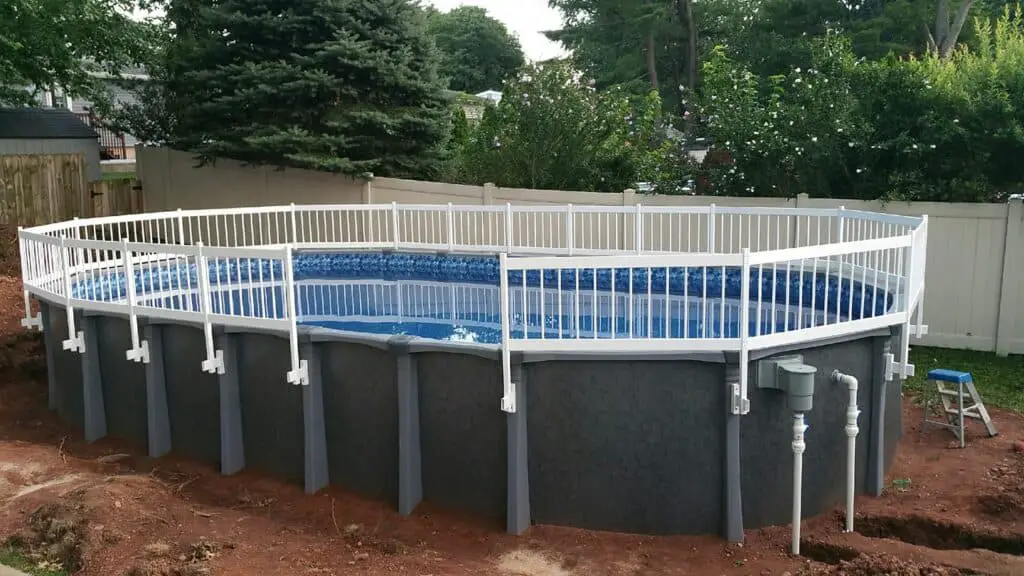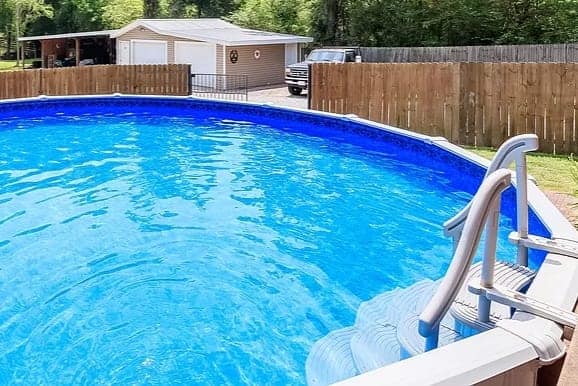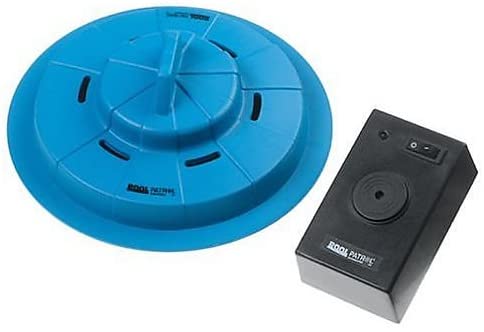When thinking about swimming pool safety, there are two big concerns. The first is drowning and the second is electrocution.

Above-ground pools are slightly safer than in grounds. This is mainly because most traditional above-ground pools are about four feet above the ground. Kids and animals that don’t know how to swim have to be able to climb into an above-ground somehow before they can drown. Inground pools are at ground level, so no climbing is needed to get in the water.
ASIDE FROM SOME BLATANT NEGLIGENCE, ABOVE-GROUND SWIMMING POOLS ARE VERY SAFE
For some, the thought of having a swimming pool brings emotions of anxiety. This is mostly from the worry of someone potentially drowning. Some potential pool owners have had a bad experience with water, don’t know how to swim well, have small children, or are generally worrisome people.
Regardless of reasons, worry about swimming pools being safe exists. Statistically, there are very, very few tragic drownings with all swimming pools and above-ground pools having the least of any. This is mainly because it’s much harder for children who cannot swim under the age of five to access the water.
12 SAFETY FEATURES AVAILABLE FOR ABOVE GROUND SWIMMING POOLS
This list is ordered from most common and practical to least.
1. Ladder
With the exception of the standard ladder that comes with the cheaper soft-sided (Intex/ Coleman) type, all above-ground pool ladders are considered safety ladders.
These are considered safety ladders because all of them have a way to restrict access to being able to climb them from the outside of the pool.
Most AG pool ladders are designed for the outside rungs to swing upward and be locked and secured and some have a way to cover the outside steps with a guard that disallows climbing access to the pool.
Regulation note: Some local municipalities will require an above-ground pool to have a minimum height from the ground of four feet or a little more. This is to ensure that the pool is high enough off the ground so that a small child cannot climb up to access the water.
2. Fencing
Most of the municipalities in the United States require a swimming pool to be within some form of fencing for safety. Most pools are installed in back yards and many back yards in the US are already fenced-in so that safety feature already exists for most.

Personally, I think installing an above-ground pool in a fenced-in yard is a good idea for both privacy AND safety reasons. Some local governments want more than that though. Some will require the area directly around the pool to have its own fence regardless if the yard is already fenced in.
Again in my personal opinion, I think double fencing in an above-ground pool is extreme and a waste of people’s hard-to-earn money.
Another option is fencing in just the pool itself. This is accomplished by installing a fence on top of the pool’s wall all the way around.
There is a fencing product specifically for above-ground pools. They are a bit of a pain to install and ending the fence with your safety ladder can be a challenge.
NOTE: Some local governments require an above-ground pool to be a minimum height off the ground. If your pool is going to be in the ground some from the yard being off level (or a semi-inground installation), then fencing in just the pool may not be accepted.
3. GFI (Ground fault circuit interrupter)
Here’s a fact that almost everyone already knows-
“Water and electricity don’t mix well”
Every swimming pool regardless of its type, shape, or size needs an electric pump for its filtration system. This means there will be electricity as close to the pool’s water as from the front of the pump (water) to the back of it (electric motor). This is where a GFI comes into play for pool safety.
What is a GFI?
A pool pump (and other electric fed add-on components) require a source of electricity. This electric source comes from wires that are attached to the electric box of the house all the way to the pump. A ground fault circuit interrupter or GFI is a device within that wire feed that will shut off the flow of electricity if there is a power surge or power flow issue.

This is an important pool safety feature because when water mixes with electricity, it causes a difference in the flow of electricity in the wire. The GFI device senses the difference and shuts off the flow of electricity.
So, if for one reason or another the electricity mixes with the pool water, thus dangerously electrifying it, the GFI will immediately shut down the flow of electricity from the power source (electric panel).
Now, this shut-off is mechanical which means the flow of electricity cannot restart until the GFI device is reset manually. Very safe.
4. Steps
Instead of just a ladder, some upgrade to getting an entry system with actual steps to replace a simple ladder. These are ideal for those needing more stable climbing access to the pool.

Legitimate pool installers don’t assemble or install any ladder, steps, or any form of entry system at all. This is because the ladder (where swimmers climb in and out of the pool) is where many accidents happen.
I started my pool installation career in the late eighties installing for a company named Recreational Factory Warehouse. In the beginning, we installers assembled and installed the ladder that came with the pool package.
Then some lady sued Rec. Warehouse for a ton of money because she slipped from her ladder and got injured in some way (I don’t know the details).
Since the lawsuit, no installer ever touched a ladder again. And I haven’t in more than 30 years.
Upgrading to steps is a big pool safety feature for anyone that has mobility issues. Pool steps have landings (instead of just ladder rungs), are usually wider, and will have one or two handrails that can assist in the pool entry.
5. Safety Pool Covers
There aren’t too many true safety cover options for above-ground pools and they are fairly pricey. They do offer a little more protection than a regular pool cover (I think anyway).
What I am mainly talking about here is any cover for an above-ground pool being used as a safety feature. And with this, it depends on what you want to keep safe.
Any kind of cover for an above-ground pool is only as safe as the way it is attached, how well it’s attached, and what material the cover is made of. A good quality solid cover that is very well secured all the way around a pool will prevent critters and small humans from getting in the water, but most use one to protect the pool water from nature’s elements, like winter in the north.
6. Safety Signs
In the case of above-ground swimming pools, the most common warning or safety sign will say “NO DIVING”. This is because above-ground pools are only made to have around four feet of water depth which isn’t even close to deep enough to safely dive in.
At this point (because we are so used to them), many think that “no diving or jumping” signs and other safety signs are only effective for insurance protection.
I feel pool safety signs do still work as an actual deterrent to people doing stupid and dangerous things involving a swimming pool. Dumb and drunk don’t mix well with swimming pools so warning signage may not work for everyone, but it does work for most. Consider adding these rules as well.
7. Door Alarm
For a period of time here in Central Florida in the late nineties, some local building departments were mandating door alarms if you got a permit with an above-ground pool.
This meant that anyone getting a new above-ground pool would also have to get a device that sounds an alarm if your back door/s or sliding glass door opened to the back yard.
Most would get one for the inspection and then disable them soon after. Not the best pool safety mandate in the world, but you can’t expect much in the way of critical thinking from a government.
In the end, though, I feel that a door alarm(when kept in operation) is a decent safety feature for those with small kids that can’t swim(hopefully yet).
8. Pool alarm/ Surface Motion Sensor
These devices have supposedly come a long way since I started seeing them a couple of decades ago. Basically, they sense when something has entered the pool surface and sets off an alarm in the house.

In reality, I don’t have much personal feedback on these products. I can only say that most who install them shut them off in a short time. Might have something to do with them falsely going off or people not truly trusting them.
9. Motion Camera
Wireless cameras used around the home have become so popular in the US. Why not use one as a safety feature for an above-ground pool?
In reality, this may be the most common safety feature for monitoring above grounds as so many have cameras pointing around the outside of their homes anyway.
10. Pool Buoy or Safety Ring
Since most above-ground pools aren’t big and are only four feet deep, a lifebuoy may not be needed very often at all. There are all kinds of unique situations though, and some may want to have something next to the pool that they can throw in to allow someone who can’t swim to hold on to keep them above water.
11. Wrist Alarms
Did having a pool surface motion sensor not work for you because it went off too much? A wrist alarm may be a better alternative for you then.
Put a device on your kid’s wrist or dog’s collar and if they fall in the pool, the alarm will go off. I have yet to see one of these in the real world, but the concept seems sound.
Personally, I’m not trusting of electronics. This may just be because I’m in my fifties and remember when humans didn’t rely on it. Or it’s because every time something electronic fails even just temporarily, I think about how something mechanical would not have.
If my phone occasionally doesn’t connect to the wi-fi, it’s usually just a short-lived annoyance that is really no big deal. Or if my card won’t read at a convenience store, I can pull out some cash to buy my gas and snack.
If a wrist alarm decides not to work just once though and just for a minute, that could be life-changing. Jus’ sayin’.
12. Bonding
I really don’t want to add bonding to this safety list for above-ground swimming pools, but since some municipalities require it when you get a permit, I’ll go ahead and mention it.
I’m not going to give you my negative opinion about whether bonding an above-ground pool is necessary or not. I will say that almost all of the thousands of above-ground pools that I have seen and worked on were not bonded. I have yet to hear of an instance when bonding an above ground saved someone or more importantly, a non-bonded above ground didn’t save someone.
THE ULTIMATE SAFETY FEATURE FOR ABOVE GROUND POOLS – MAKING SURE EVERYONE IN THE HOUSEHOLD KNOWS HOW TO SWIM
Now before your brain goes to “Sure thing, Captain Obvious”, hear me out.
I have been in the swimming pool business for 35 years and can tell you it’s very common for parental units to not teach their young kids to swim. Many adults can’t swim either which prevents them from getting even an above-ground pool that is only deep enough for the water to come to their chest.
Teaching young ones to swim (and yourself) is a chore to do. If you choose lessons, they will cost money and be time-consuming. Too bad. Do it anyway if you plan on having a swimming pool.
Teaching everyone in the household to swim reduces the chance of a pool tragedy down to almost zero. Installing to pool too far from any roof (that some drunk uncle or teenager wants to jump from) will take away most of the other risks, but that’s a topic for another article.


Can you elaborate more on bonding? We just had a resin pool installed and they installed an inline bonding lug (I think that’s the name) for the wire to be connected to that, the pump, and the wall seam (I think!) but we keep getting conflicting info on whether bonding is even needed. Thanks!
I don’t want to elaborate on bonding as I’m a pool guy and not in the electrical field. I will say that the concept of bonding (an above ground pool) is purely theoretical. Also, I have installed or worked on maybe 10k AG pools in my now 37 years and almost all of them were NOT BONDED and had zero issues. With this info, you can decide whether it’s a complete waste of money and worry or not.